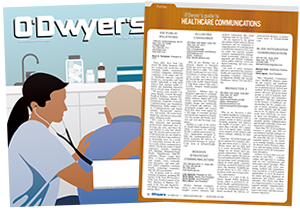 Donna L. LaVoie Donna L. LaVoie |
What makes orphan disease communications different is the patient population. Orphan diseases often have close-knit patient communities who are often dealing in a disease area in which there is no effective therapy. When targeting communications to a particular audience, it is important to remember that other audiences are always listening.
|
|
Without a doubt, large and small companies may have different disclosure and communications requirements because of internal policies, general commercial views, and regulatory compliance issues. These factors can sometimes create challenges, particularly for larger companies that have more policies in place with regard to regulatory compliance.
Audiences
Throughout the process, audiences may include physicians and providers, regulatory agencies, foundations, patients, families, and advocacy groups, as well as investors and others. For orphan diseases, governments are also audiences, since many are involved in providing access under treatment protocols to patients prior to approval and also provide the manufacturer with a supply agreement in advance.
Orphan drugs are often in a class by themselves since the number of patients in a pivotal program is often smaller than a traditional product. As a result, there are communications considerations such as managing expectations of drug access to patients, their physicians and other key stakeholders: including investors who often are trying to understand and project the company’s potential product revenue and resulting profit to help them put a value on the company.
The environment
An orphan disease environment is often more personal than large-scale pharmaceutical development. While the treatment of any disease or illness has its obvious personal and emotional overtones, an orphan situation can be more challenging, given the low disease awareness and limited therapies.
Orphan drugs communities have powerful patient voices who are partners with the industry in drug development. There are personal relationships and a special bond among patients, families, physicians and patient advocacy groups. Foundations and other advocacy groups are founded and heavily populated by people with personal interests together with families, industry, government, physicians and others working toward finding a treatment, a cure or a way to save the life of a family member.
Communicators need to understand that patients and their families, physicians, researchers, advocacy groups and other stakeholders have profound personal stakes in gaining recognition of the importance of the disease and its devastating consequences, the searches for effective treatments, and the importance of their roles in the process.
They also need to recognize that there may be differences of opinions about care, treatment, and research directions. Advocacy groups and others may be in competition with each other.
Tone
As a result, the content of communications must be carefully considered. It is important to understand the specific needs of each of the audiences and the factors that may prejudice their perceptions. In that context, it is important to recognize that all stakeholders can see all communications and balancing conflicting demands requires experience and sensitivity.
When framing communications, it is essential to understand the personal motivations of audience members. Materials aimed at them need to have a personal tone and reflect an understanding of the importance of the problem to those immediately impacted by it.
At the same time, investor relations and other financial and business releases and medical communication materials must be professional and regulatory compliant– prepared without forgetting that they will also be read by people with very personal interests.
Master planning
A master plan is key to the success of any communications program. It needs to begin with basics: the definition of the program’s objectives; the themes and messaging that will help to realize those objectives; the audiences, strategy and tactics; the use of key opinion leaders and patients, talking points and media.
Milestones and content also need to be included: when to start talking about the drug candidate, clinical trial initiatives, pricing, patient assistance programming, patient numbers, and other matters.
Integration
Integration is key to any multi-faceted communications program. A pharmaceutical communications program is a complex assemblage of virtually all contemporary methods and media, content and messages, all aimed at a very broad mix of audiences with different agendas. An effectively integrated program will capitalize on the strengths of the various methods and media designed to help the program achieve its objectives, to enlist support where and as needed, and to do more.
The integration must also soften the edges among differences in priorities as well as other considerations. Some differences are universal: shareholders would like to see pricing that will enhance their returns; payers want pricing that will save them money. Ultimately, saving lives is a critical message.
Other differences may be less readily apparent. Various stakeholders may have differences in treatment approaches, priorities, and many other factors related to the development process, scientific issues, pricing, schedules, and virtually anything else related to the development of a drug and its use and distribution.
Planning and executing a communications program for any product development, launch, and follow-up is a series of complex challenges. While orphan drugs have much in common with any medical products, there are differences that impact the strategy, organization, execution and content of communication programs. Their environment is more intense and more complex, and their success requires higher levels of experience and expertise.
***
Donna L. LaVoie is President and CEO of LaVoieHealthScience.



 Lo Isidro, senior director at Real Chemistry with more than a decade of strategic communications and PA experience, has joined Narrative Strategies.
Lo Isidro, senior director at Real Chemistry with more than a decade of strategic communications and PA experience, has joined Narrative Strategies. Nelson Fernandez, former North American chair of APCO Worldwide and managing director of Burson-Marsteller, has joined Volunteers in Medicine Berkshires as director of communications and PA.
Nelson Fernandez, former North American chair of APCO Worldwide and managing director of Burson-Marsteller, has joined Volunteers in Medicine Berkshires as director of communications and PA. Lilit Bargar, who was most recently an EVP in the healthcare practice at Weber Shandwick, comes on board at GCI Health as EVP, corporate practice lead.
Lilit Bargar, who was most recently an EVP in the healthcare practice at Weber Shandwick, comes on board at GCI Health as EVP, corporate practice lead.
 Five ways that successful thought leaders are made.
Five ways that successful thought leaders are made.


 Have a comment? Send it to
Have a comment? Send it to 
No comments have been submitted for this story yet.